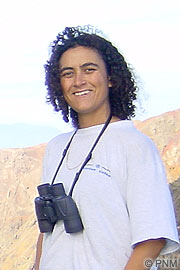

 |
||
 |
||
Vol. 6 (2): December 2003 |
Download this article
|
|
SAVING SEALS AT MADEIRA…
|
 |
|
|
|
It is just over 10 years ago now that I visited Madeira for the first time, to study the Mediterranean monk seal as part of my student training. At the time, I could not have imagined that this wonderful creature would “hook” me in Madeira for years to come. I was only a student looking for something exciting to study. But after my first stay at the Desertas Islands something changed.
It was a stay of 2 weeks, during which I was involved in all the procedures that are applied to protect and monitor the species. During those days I had an experience that I could never have dreamt about… I was really surprised by the magnificence of these seals in the wild and it was fantastic to join such an enthusiastic team dedicated to the monk seal cause.
I remember the first time that I saw a monk seal, well, actually there were two, probably a female and her pup. They were playing near the beach, and I got so excited that I even forgot to take any notes! It took me a while, but I can finally say I have now managed to control this!
The monitoring of the monk seal population is based on such observations. For that purpose there are lookout sites established around the islands, from where we can spend anything up to five hours waiting for the seals to appear. Sometimes the observation effort seems to be interminable – that’s when we do not observe any seal at all. But when we make one single sighting, we think that all the time spent there has been worth it. And the person that comes to pick us up from the lookout sites by boat (all the observatories are reached from the sea) always knows if we have seen a monk seal or not before we even say a word, because the satisfaction or the disappointment is always there, written on our faces.
So many observations have been made over the years, but 1997 was definitely a remarkable year for us. It was that year we first saw monk seals on an open beach at the Desertas Islands and even around Madeira Island. The funny thing is that we used to joke about this possibility: “One day we’ll see monk seals on these beaches,” we used to say, or “one day they’ll be so common that they’ll return to Madeira again.”
I can now say that 1997 was probably the period that I had the strongest emotions on the Desertas Islands, not only because of the fantastic observations we had and the things we learned, but also because of the risks we took just to observe the seals in any weather or at any time, even in very stormy seas. We maintained our observation, over several days, of two beach-loafing adult seals with a single pup. When we confirmed that both were females and were nursing the pup, we discovered, just a few yards away, an abandoned infant. It was clear to us that its chances of survival were close to nil, so we decided to act. We relocated the young animal, placing it at safe distance from the females, just within ear-shot. Then, we waited for several moments that seemed like hours, since we were so anxious. Suddenly, our “abandoned” pup cried out and, out of nowhere, a female answered and came closer. Mother and pup, reunited, nuzzled for a while and then the female started to feed her offspring – it was just perfect! I believe this episode to be one of the best examples describing the importance of monk seal monitoring for the safeguarding of the species.
It was also in 1997 that we first saw monk seals around Madeira Island, from where they had disappeared at the end of the 1980s. Now, occasional encounters between these animals and the locals are happening, and public reaction is generally very positive. But the presence of monk seals around Madeira also has another significance: Madeirans are now fully aware of their presence, and are much more concerned about their preservation. Today, people’s attitudes towards the seal have changed, and our responsibility is that much greater.
These major achievements are the result of our conservation work at the Desertas Islands. Henrique Costa Neves, former Director of the Natural Park Service of Madeira, was responsible for its implementation. Protection in situ, monitoring without disturbance and public awareness were the main considerations of his strategy. Although Henrique is no longer responsible for the protection of the species, his philosophy is still in practice here, a philosophy that has proven a great success.
Rosa Pires, November 2003
Copyright © 2003 Rosa Pires, The Monachus Guardian. All Rights Reserved |